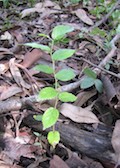DECLARED PLANTS FOUND IN THE MOGGILL CREEK CATCHMENT – MARCH 2018
This table includes photographs of listed species where available. Photographs were taken by Bryan Hacker unless otherwise indicated, mostly in or near the Moggill Creek Catchment. Brief comments are provided on distinguishing characteristics, published control methods, and status and rating. The table has 5 categories: Trees, Shrubs, Vines, Herbaceous and Understory plants, Aquatic and Semi-aquatic plants. Species included are those recorded for our Catchment which also appear in BCC’s Brisbane Invasive Species Management Plan. National and State status (see Restricted Invasive Plants of Queensland publ. 2016) are also included.
– NEAL: National Environmental Alert List (National – AUS)
– C3: A person must not distribute the invasive plant either by sale or gift, or release it into the environment (State – QLD)
– Eradicate: Priority for early detection and eradication (Brisbane City Council – BNE)
– Contain: Priority for containment and reduction (Brisbane City Council – BNE)
– Reduce: Reduce population as part of routine maintenance (Brisbane City Council – BNE)
– Rating: This is a subjective rating of environmental threat or damage on a 1-5 scale, ***** indicating most serious environmental weed
| 1. TREES (including PALMS) |
||||||
Species |
Detailed view | Scientific and common name | Distinguishing characteristics | Control | Status and Rating | Additional local notes |
|
|
Celtis sinensis Chinese celtis |
Deciduous; leaves simple, in a plane, slightly toothed margins |
Cut-stump and glyphosate; stem injection; various other herbicides For more info please see:
|
AUS: nil QLD: C3 BNE: Reduce Rating: ***** |
Mainly around creeks. Seedling regeneration a major concern, requiring hand removal or cut-stump treatment.
A major food source for fruit-eating birds including Pale-headed Rosellas. Replace (lower bank) Ficus coronata and (upper bank) local riparian rainforest species.
Replacement species: (lower bank) Ficus coronata and (upper bank) local riparian rainforest species.
|
|
|
|
Cinnamomum camphora Camphor Laurel |
Leaves simple, with under surface lighter; smell of camphor when crushed |
Cut-stump and glyphosate; stem injection; various other herbicides For more info please see:
|
AUS: nil QLD: C3 BNE: Reduce Rating: ***** |
Mainly around creeks.
Important food source for fruit-eating birds and host for Blue Triangle butterfly.
Replacement species: Cryptocarya triplivervis (for Blue Triangle butterfly), Syzygium spp. (upper bank, fruit-eating birds), Melaleuca bracteata and other riparian rainforest species.
|
|
|
|
|
Corymbia torelliana Cadaga or cadaghi |
Pronounced sock; young leaves red, hairy | Cut-stump and herbicide; stem injection For more info please see: BCC weed identification |
AUS: nil QLD: nil BNE: Reduce Rating: ** |
Attracts honeyeaters, lorikeets and bees.
Replacement species: Corymbia tesselaris, C. citriodora or local species of Eucalyptus.
|
|
|
Koelreuteria elegans ssp. formosana Golden rain tree |
Bipinnate leaves; leaflets alternate, not opposite as in white cedar | Cut-stump and glyphosate; stem injection For more info please see:
|
AUS: nil QLD: NEAL BNE: Reduce Rating: *** |
A prolific seeder, spread by birds. Replacement species: Cupaniopsis parvifolia or Melia azederach. |
|
  |
Ligustrum lucidum Broadleaf privet |
Leaves opposite, 4-13 cm long | Cut-stump and glyphosate; stem injection; various other herbicides For more info please see:
|
AUS: nil QLD: C3 BNE: Contain Rating: ** |
A significant weed tree in the Moggill Creek catchment. Produces large numbers of seeds, which are dispersed by birds.
Replacement species: Jagera pseudo-rhus or Mallotus philippensis. |
|
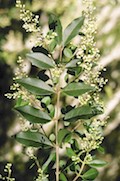 |
Ligustrum sinense Small-leaved privet |
Leaves opposite, 2-7 cm long | Cut-stump and glyphosate; stem injection; various other herbicides For more info please see:
|
AUS: nil QLD: C3 BNE: Contain Rating: * |
Less common in the Moggill Creek Catchment than L. lucidum. Seeds spread by birds. Tends to occur close to streams.
Replacement species: riparian rainforest species. |
|
 |
Morus alba White mulberry |
Leaves simple, to 11cm x 8cm, bright green | Cut-stump or basal bark and herbicide For more info please see: BCC weed identification |
AUD: nil QLD: nil BNE: Reduce Rating: ** |
Common along waterways and difficult to kill.
Replacement species: riparian rainforest species |
|
 |
Pinus elliottii Slash pine |
Tree with needle-like, jointed branchlets, appearing like leaves | Cut and remove before seeding For more info please see: BCC weed identification |
AUD: nil QLD: nil BNE: Reduce Rating: * |
Seeds spread by wind.
Suggested replacements: Araucaria cunninghamii or Podocarpus elatus. |
|
 |
Schefflera actinophylla Umbrella tree |
Leaves on long stalks (petioles) with 7-16 leaflets to 25cm long | Cut-stump and herbicide; stem injection For more info please see: BCC weed identification |
AUD: nil QLD: C3 BNE: Reduce Rating: ** |
Flowers or fruit are enjoyed by lorikeets. Seed spread by birds and other animals. | |
 |
Schinus terebinthifolius Broad-leaved pepper tree |
Leaves distinctive, leaflets 5-11, in pairs with one terminal leaflet | Cut-stump and glyphosate; stem injection. Also fluoxypyr For more info please see:
|
AUD: nil QLD: C3 BNE: Reduce Rating: * |
Generally occurs along waterways and tolerant of somewhat saline soils. Spread by seed-eating birds and mammals.
Replacement species: appropriate local riparian species. |
|
 |
Spathodea campanulata African tulip tree |
Leaves opposite, to 50cm long, each with 7-17 leaflets | Cut-stump and herbicide; stem injection
For more info please see:
|
AUD: nil QLD: NEAL BNE: Reduce Rating:**** |
Seeds winged and wind-blown. May sucker from damaged roots.
Suggested replacements: Harpullia pendula or Brachychiton discolor. |
|
 |
Syagrus romanzoffiana Cocos palm or Queen palm |
Palm with fruit 2-3cm long, yellow-orange, borne in large clusters | Cut below lowest leaf or at ground level – herbicide not necessary
For more info please see:
|
AUD: nil QLD: nil BNE: Reduce Rating: * |
Fruit toxic to flying foxes.
Replacement species: Planting native palms would be preferred, although none known to be native to the Moggill Creek catchment.
|
|
|
|
 |
Tipuana tipu Tipuana |
Leaves alternate, with 9-29 leaflets, these in alternating pairs, with one terminal leaflet; fruit winged |
Cut-stump and glyphosate; stem injection; various herbicides
For more info please see:
|
AUD: nil QLD: NEAL BNE: Reduce Rating: **** |
Fruit is winged (technically a samara) and wind-blown.
Suggested replacements: Jagera pseudo-rhus, Harpullia pendula or Brachychiton discolor. |
2. SHRUBS (including cacti and bamboo) |
||||||
| Species | Detailed view |
Scientific name |
Distinguishing characteristics |
Control |
Status and Rating |
Additional local notes |
 |
Agave spp Agave Century plant |
Leaves 1-2m long f | Basal bark or complete removal
For more info please see:
|
AUD: nil QLD: nil BNE: Reduce Rating: ** |
Several species. Mature plants seed from a tall flowering stem.
Suggested replacements: replace after removal with appropriate local trees and shrubs. |
|
| Images not currently available | Baccharis halimifolia Groundsel bush |
Shrub to 3m tall with wedge-shaped leaves 2.5-5cm long, 1-1.5cm wide | Hand-pull; cut stump then foliar spray – glyphosate or various other herbicides
For more info please see:
|
AUD: nil QLD: C3 BNE: Contain Rating: * |
Now not common in the Moggill Creek catchment. Seeds carried by wind.
Suggested replacements: appropriate local shrubs – Dodonaea spp., Hovea acutifolia, Trema aspera. |
|
 |
 |
Cascabela thevetia Yellow oleander Captain Cook bush |
Milky sap; flowers yellow and bell-shaped, to 5cm diameter | Cut-stump and glyphosate; stem injection; various other herbicides
For more info please see:
|
AUD: nil QLD: C3 BNE: Reduce Rating: ** |
All parts of plant very poisonous. Seed reportedly spread in garden waste.
Suggested replacements: Acacia spp., Mallotus philippensis, Harpullia pendula. |
 |
Cestrum parqui Green cestrum |
Shrub to 3m, leaves to 12cm long, 2.5cm wide, unpleasant smell when crushed | Cut stump or spot spray – glyphosate or various other herbicides
For more info please see:
|
AUD: nil QLD: nil BNE: Reduce Rating: * |
Toxic. Seed spread by birds. Not common in the Moggill Creek catchment. | |

© Malcolm Frost
|
Dichrostachys cinerea Sickle bush |
Strong alternate thorns to 8cm long | Cut-stump and glyphosate
For more info please see: BCC weed identification |
AUD: nil QLD: nil BNE: Reduce Rating: * |
Occurs in the vicinity of Rafting Ground Park. | |
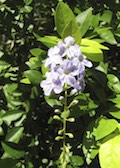 Flowers  Fruit |
Duranta erecta syn, D. repens and D. plumeri Duranta |
Shrub with light blue flowers and orange berries | Cut stump, basal bark or spot spray; various herbicides
For more info please see:
|
AUD: nil QLD: nil BNE: Reduce Rating: * |
Seed dispersed by birds. Commonly grown in local gardens. | |

|
Lantana camara Lantana |
Shrub | Hand-pull when small; cut stump, basal bark or spot spray; various herbicides For more info please see:
|
AUD: WONS QLD: C3 BNE: Reduce Rating:***** |
Several varieties with different-coloured flowers.
Provides good habitat for small birds and should be replaced progressively, avoiding leaving bare ground. Suggested replacements: Trema tomentosa, Dodonaea spp., Bursaria spinosa, Hovea acutifolia |
|
 |
 |
Leucaena leucocephala (all ssp.) Leucaena |
Leaves bipinnate, leaflets to 20 mm long | Cut-stump and picloram For more info please see:
|
AUD: nil QLD: nil BNE: Reduce Rating: ** |
Seeds prolifically, bearing large numbers of seed pods, the seeds reportedly carried by small animals. Seeds should be collected and destroyed as longevity of 7-20 years has been reported. |
| Images not currently available | Ludwigia longifolia Ludwigia |
Herbaceous annual shrub to 3m tall | Hand-pull, foliar spray For more info please see: BCC weed identification |
AUD: nil QLD: nil BNE: Reduce Rating: * |
Distinguished from other local Ludwigia spp. in being an erect hairless annual with alternate leaves 10-20cm long, the fruit prominently 4 angled. | |
 |
Nerium oleander Oleander |
Well-known shrub, rarely invasive | Cut stump or basal bark For more info please see: BCC weed identification |
AUD: nil QLD: nil BNE: Reduce Rating: * |
Highly toxic.
Suggested garden replacements: Hymenosporum flavum and Hibiscus heterophyllus. |
|
 Seedling |
  |
Ochna serrulata Ochna |
Shrub to 2m, narrow shiny leaves, with finely toothed wavy margins | Cut stump or basal bark; various herbicides For more info please see:
|
AUD: nil QLD: nil BNE: Contain Rating: **** |
A major threat to sclerophyll woodlands in the Moggill Creek catchment. Difficult to control and several passes are usually necessary. Good habitat for some birds, notably Whip Birds. Suggested replacements: Trema tomentosa, Dodonaea spp., Bursaria spinosa, Hovea acutifolia. Seed distributed by birds but loses viability within 12 months. |
 |
Opuntia stricta Spiny pest pear Prickly pear |
Broad and flattened spiny stems | Hand-pull when small (don’t leave on ground or it will re-grow); basal bark/cut stump; foliar spray; various herbicides
For more info please see: BCC weed identification |
AUD: WONS QLD: C3 BNE: Reduce Rating: * |
Uncommon in the Moggill Creek catchment. | |
 Phyllostachys aurea |
 |
Phyllostachys aurea and P. nigra Golden Bamboo Black Bamboo |
Loosely clumping, stems to 7m | Cut stump and glyphosate; complete removal For more info please see:
|
AUD: nil QLD: nil BNE: Reduce Rating: *** |
Purposefully planted on a number of properties. Flowering is very rare and plants form dense clumps through producing underground rhizomes. |
 |
  Fruit |
Psidium guajava Yellow guava |
Opposite leaves to 15cm long | Cut-stump and herbicide; stem injection For more info please see: BCC weed identification |
AUD: nil QLD: nil BNE: Reduce Rating: *** |
Introduced as a fruit tree but now widely regarded as a weed. Seeds distributed by fruit-eating birds and flying foxes.
Suggested replacements: Harpullia pendula, Jagera pseudorhus. |
 |
Raphiolepis indica Common Indian hawthorn |
Shrub with clusters of pinkish flowers c. 12 mm across | Cut stump, then foliar spray or basal bark For more info please see: BCC weed identification |
AUD: nil QLD: nil BNE: Reduce Rating: * |
Not common in the district.
Seed distributed by seed-eating birds. Suggested replacements: Trema tomentosa, Dodonaea spp., Bursaria spinosa, Hovea acutifolia. |
|
  |
Ricinus communis Castor oil plant |
Palmate leaves to 60cm across, hollow stems | Hand-pull seedlings; control before seeding; glyphosate, 2,4D or triclopyr
For more info please see:
|
AUD: nil QLD: nil BNE: Reduce Rating: *** |
Mainly found along waterways. When ripe, fruit explodes, throwing the seed several meters. Leaves and seeds toxic.
Suggested replacement for flood-prone areas: Lomandra hystrix; Casuarina cunninghamiana |
|
 |

|
Senna pendula var. glabrata Easter cassia |
Leaves with 3-5 pairs of leaflets, no terminal leaflet; leaflet margins pallid; pods c. 6mm diameter | Hand-pull young plants; collect any ripe seed for disposal; cut stump and glyphosate or fluroxypyr
For more info please see:
|
AUD: nil QLD: nil BNE: Reduce Rating: ** |
Previously listed as Cassia coluteoides. Flowers spring and autumn (Easter).
Suggested replacements: Senna sophera and Senna acclinis for Common Migrant and Lemon Migrant butterflies |
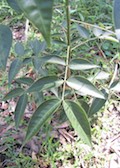 |
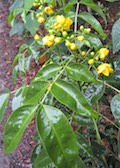 |
Senna septemtrionalis Arsenic bush |
Leaves with 3-5 pairs of leaflets, no terminal leaflet; leaflets acutely pointed | Hand-pull young plants; collect any ripe seed for disposal; cut stump
For more info please see: BCC weed identification |
AUD: nil QLD: nil BNE: Reduce Rating: * |
Previously listed as Cassia floribunda. No direct evidence of toxicity. Flowers Autumn.
Suggested replacements: Senna sophera and Senna acclinis for Common Migrant and Lemon Migrant butterflies.
|
  |
Solanum mauritianum Wild tobacco tree |
Shrub to 4m, leaves to 30cm, densely covered with felty hairs | Cut stump or basal bark; various herbicides For more info please see:
|
AUD: nil QLD: nil BNE: Reduce Rating: *** |
Seeds spread by seed-eating birds. Poisonous to stock; flowers Autumn to Spring. | |
 |
Solanum torvum Devil’s fig |
Stem with broad-based spines; leaves large with about 7 broad lobes | Cut stump or basal bark
For more info please see: BCC weed identification |
AUD: nil QLD: nil BNE: Reduce Rating: *** |
Flowers mainly in Spring.
Seed spread by fruit-eating birds. |
|
|
|

|
Tecoma stans Yellow bells |
Shrub with 3-13 hairless leaflets; flowers yellow | Hand-pull young plants; collect seed for disposal; cut stump and glyphosate
For more info please see:
|
AUD: nil QLD: nil BNE: Reduce Rating: ** |
Seed is wind-dispersed. |
| 3. VINES |
||||||
| Species | Detailed view |
Scientific name |
Distinguishing characteristics |
Control
|
Status and Rating |
Additional local notes |
|
|

|
Anredera cordifolia Madiera vine |
Fleshy-leaved vine, tubers in leaf axils | Cut stump and/or scrape stem and herbicide, hand weed with care, remove all material. Cut stems continue to survive in the canopy so stem scraping often preferred. Several herbicides listed.
For more info please see:
|
AUD: WONS QLD: C3 BNE: Reduce Rating:***** |
Very invasive – a priority for removal where it occurs.
Propagates through tubers formed in leaf axils. Very rarely reported to produce seed. Cut stems continue to survive in the canopy so stem scraping often preferred. |
 |
Araujia sericifera and A. hortorum White moth plant |
Leaves triangular, opposite; sap milky | Spot spray, fluoxypyr
For more info please see:
|
AUD: nil QLD: nil BNE: Contain Rating: ** |
Less frequently noted in the Moggill Creek catchment than other exotic vines. | |

|
Aristolochia elegans Dutchman’s pipe |
Vine with broad, rather heart-shaped leaves | Hand-pull; cut stump or basal bark and herbicide For more info please see: BCC weed identification |
AUD: nil QLD: C3 BNE: Contain Rating: *** |
Toxic to larvae of the Richmond Birdwing butterfly.
Leaves are similar to those of the native Stephania japonica (tape vine). |
|
 |
 |
Asparagus africanus Climbing asparagus |
Climbing prickly stems | Dig out; several herbicides recommended.
For more info please see:
|
AUD: WONS QLD: C3 BNE: Contain Rating:***** |
Reproduces by seed, which is spread by birds and probably by other animals. If digging out, remove entire crown or hook into a low fork of a tree to prevent re-establishment. |
 |
 
|
Caesalpinia decapetala Wait-a-while Mysore thorn |
Stems and leaves prickly, leaves bipinnate, leaflets 1-2 cm long, in pairs | Remove seedlings by hand; metsulfuron-methyl only registered herbicide
For more info please see:
|
AUD: nil QLD: nil BNE: Reduce Rating: *** |
Found along riparian areas. Stems and leaves prickly. Local (uncommon) native C. scortechinii has pods 3-5cm long, cf. 6-10cm long in C. decapetala. |
 |
 |
Cardiospermum grandiflorum Balloon vine |
Leaves distinct, with lobed leaflets; stems hairy | Hand-pull; cut stump and herbicide; several herbicides listed
For more info please see:
|
AUD: nil QLD: C3 BNE: Reduce Rating: **** |
A major weed of riparian areas. Fruit and seed mostly wind-dispersed.
Leaves somewhat similar to those of the common native vine Cayratia clematidea (slender grape). |
 |
Desmodium uncinatum Silver leaf, Desmodium or Velcro plant |
Leaves with 3 leaflets, pale towards mid-rib; leaves and stems sticky owing to hooked hairs |
Hand-pull; dig out tap root For more info please see: BCC weed identification |
AUD: nil QLD: nil BNE: Reduce Rating: *** |
Readily distinguished by its ‘sticky’ leaves, stems and pods. Fruit dispersed by passing animals.
Suggested replacements: locally native understorey plants. |
|

|

|
Dolichandra unguis-cati Cats claw creeper |
Leaves opposite, each with 2 leaflets and 3 tiny ‘claws’ between | Foliar spray / cut stump with dicamba, picloram or glyphosate (dicamba more effective).
For more info please see:
|
AUD: WONS QLD: C3 BNE: Contain Rating:***** |
A major threat to forest ecosystems in the Moggill Creek catchment.
Landowners encouraged to control young plants before they take over and to prevent flowering or established colonies by cutting and poisoning ascending stems. |
 |
Ipomoea cairica Mile a minute |
Twining vine, the alternate leaves with 5 or 7 prominent lobes | Hand pull, cut stump or stem scrape plus herbicide, several listed
For more info please see:
|
AUD: nil QLD: nil BNE: Reduce Rating: **** |
Widespread in the Moggill Creek catchment along riparian areas.
Mostly spreads vegetatively. |
|
 |
Ipomoea indica Morning glory |
Twining vine, the alternate leaves broadly heart-shaped, sometimes with 3 or 5 lobes | Hand pull, cut stump or stem scrape plus herbicide – several listed
For more info please see:
|
AUD: nil QLD: nil BNE: Reduce Rating: **** |
Reproduces vegetatively. Leaves quite similar to those of the locally common native Ipomoea plebeia (bellvine), which has white flowers c. 1cm long (cf. blue flowers 5-8cm long in I. indica). | |
| Images not currently available | Lonicera japonica Japanese honeysuckle |
Vine with leaves to 75mm long in opposite pairs | Cut stump or foliar spray; glyphosate or picloram
For more info please see:
|
AUD: nil QLD: nil BNE: Reduce Rating: * |
Not a major weed in the Moggill Creek catchment. | |

|
Macroptilium atropurpureum Siratro |
Leaves with 3 leaflets up to 7 cm long, lower leaflets with pronounced lobe | Hand pull; foliar spray several herbicides listed
For more info please see:
|
AUD: nil QLD: nil BNE: Reduce Rating: *** |
Replace with locally native grasses and other understorey plants. Seed likely to remain viable in soil for several years. | |
  |
Macrotyloma axillare Perennial horse gram |
Vine with yellow pea flowers in leaf axils | Cut stump then foliar spray
For more info please see: BCC weed identification |
AUD: nil QLD: nil BNE: Reduce Rating: *** |
Seed likely to remain viable in soil for several years. Suggested replacements: locally native grasses and other understorey plants. |
|
 |
  |
Neonotonia wightii Glycine |
Vine, leaves with 3 leaflets to 15 cm long, 12cm broad | Hand-pull, cut stump and glyphosate; spot spray with dicamba or picloram + triclpyr For more info please see:
|
AUD: nil QLD: nil BNE: Reduce Rating:***** |
A major threat, primarily along riparian areas in the Moggill Creek catchment. Note that several native species of the genus Glycine occur in the Moggill Creek catchment.
Leaves are much smaller than those of N. wightii and they are not weedy. Seeds may remain viable in soil for ten or more years. |
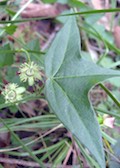
|
Passiflora suberosa Corky passion vine |
Climber with corky bark towards base of stem | Hand pull or cut stump and foliar spray with gluphosate
For more info please see:
|
AUD: nil QLD: nil BNE: Reduce Rating: * |
Flowers 1-2cm diameter, cf >6cm diameter in local natives P. herbertiana and P. aurantia.
Also 2 glands halfway along petiole (cf. glands just below blade in natives) |
|
 Seedling |
   © Val Price |
Solanum seaforthianum Brazilian nightshade |
Vine with alternate leaves partly or completely divided to midrib with 3-9 lobes; flowers lavender-coloured | Hand-pull or cut stump and herbicide
For more info please see: BCC weed identification |
AUD: nil QLD: nil BNE: Reduce Rating: *** |
Seed spread by fruit-eating birds. Seedlings are frequently found in the Moggill Creek Catchment, suggesting that this species is an increasing threat. |
 |
Syngonium spp. Arrowhead vine |
Vine | Stem scrape or cut stump and foliar spray glyphosate or fluroxypyr
For more info please see:
|
AUD: nil QLD: nil BNE: Reduce Rating: * |
Propagates largely vegetatively and generally found in more settled areas of the Moggill Creek catchment. | |
 |
Thunbergia alata Black-eyed Susan |
Slender-stemmed vine with bright orange flowers with black throat | Hand pull, foliar spray
For more info please see: BCC weed identification |
AUD: nil QLD: nil BNE: Reduce Rating: * |
Reproduces vegetatively and by seed.
Suggested replacements: locally native understorey plants. |
|
| 4. HERBACEOUS AND UNDERSTOREY PLANTS |
||||||
| Species | Detailed view |
Scientific name |
Distinguishing characteristics |
Control |
Status and Rating |
Additional local notes |
 |
Ageratina riparia Mistflower |
Sprawling plant; opposite leaves with serrated margins; occurs close to streams | Hand pull before seeding; several herbicides listed
For more info please see:
|
AUD: nil QLD: nil BNE: Reduce Rating: *** |
A significant threat along waterways, tolerating quite heavy shade.
Suggested replacements: locally native understorey plants including Lomandra hystrix. |
|
 |
Alternanthera pungens Khaki weed |
Creeping, somewhat hairy stems | Foliar spray; several herbicides listed For more info please see:
|
AUD: nil QLD: nil BNE: Reduce Rating: * |
A weed of disturbed areas. Reproduces mainly by seed.
Suggested replacements: locally native herbaceous and understorey plants. |
|
 |
 |
Ambrosia artemisiifolia Annual ragweed |
Leaves to 10cm long and deeply divided; pollen may cause health problems | Hand pull before seeding; several herbicides listed For more info please see:
|
AUD: nil QLD: C3 BNE: Reduce Rating: *** |
Can cause allergic reactions. Seeds prolifically in autumn.
Removal before seeding effective in terms of long-term control. |
 |
 |
Argemone ochroleuca Prickly poppy or Mexican poppy |
Prickly herb to 1m tall; flowers pale yellow to 7cm diameter | Hand pull before seeding; several herbicides listed For more info please see:
|
AUD: nil QLD: nil BNE: Reduce Rating: * |
|

|
Arundo donax Giant reed |
Rhizomatous perennial grass to 6m tall, with large, open flower heads | Cut stump followed by aquatic-approved herbicide recommended by Florabase (WA) For more info please see:
|
AUD: nil QLD: nil BNE: Reduce Rating: **** |
Mainly along waterways, including lower Moggill Creek.
Clumps propagate vegetatively and reproduction also by seed. Like Pennisetum purpureum, this species is also likely to provide wildlife habitat that is difficult to replace. |
|
 |
Asclepias curassavica Red-head cotton bush |
Erect perennial herb to 1m tall; milky sap; flowers yellowish to orange | Hand pull or dig out; foliar spray
For more info please see: BCC weed identification |
AUD: nil QLD: nil BNE: Reduce Rating: * |
Uncommon in the Moggill Creek catchment.
Reproduces by seed. |
|
 Asparagus aethiopicus |
 Asparagus aethiopicus |
Asparagus aethiopicus ‘Sprengeri’ Ground asparagus |
Long, arching prickly stems from a central point | Dig out; several herbicides recommended For more info please see:
|
AUD: WONS QLD: C3 BNE: Contain Rating:*** |
Reproduces by seed, which is spread by birds and probably by other animals.
If digging out, remove entire crown or hook into a low fork of a tree to prevent re-establishment. |
 Bryophyllum daigremontianum x B. tubiflorum |
Bryophyllum x houghtonii Mother of millions |
Erect stems with fleshy leaves producing tiny propagules along margins | Hand pull taking care to bag entire plants for safe disposal; several herbicides listed For more info please see:
|
AUD: nil QLD: C3 BNE: Reduce Rating:***** |
Toxic to livestock. Several forms, including the similar Bryophyllum delagoense, occur in the Moggill Creek catchment.
Difficult to eliminate. |
|
 |
Bryophyllum pinnatum Live plant Resurrection plant |
Erect, to 1m tall; leaves succulent, upper leaves with 3-5 leaflets | Hand pull taking care to bag entire plants for safe disposal For more info please see: BCC weed identification |
AUD: nil QLD: nil BNE: Reduce Rating: ** |
Toxic to livestock | |
 |
Callisia fragrans Purple succulent |
Prostrate herbaceous plant spreading by means of long stolons. Leaves may be green or purple. |
Hand pull, removing all of the plant. Putting in a heap and covering with black plastic for several months is effective.
For more info please see: BCC weed identification |
AUD: nil QLD: nil BNE: Reduce Rating: *** |
||
 |
 |
Chloris gayana Rhodes grass |
Stoloniferous grass with 8-17 spikes at tip of flowering stem. The native C. ventricosa is similar but <9 spikes and narrower leaves (3mm cf 2-9mm) | Dig out by hand or foliar spray For more info please see: BCC weed identification |
AUD: nil QLD: nil BNE: Reduce Rating: *** |
An important pasture species.
Suggested replacements: In bushland, control before seeding and replace with locally native grasses and understorey plants. |
 |
Chloris virgata Feathertop, Rhodes grass |
A tufted grass to c. 1m with distinctive flower heads | Hand pull before seeding For more info please see: BCC weed identification |
AUD: nil QLD: nil BNE: Reduce Rating: * |
A minor weed but quite common along roadsides. | |
 |
 |
Dyschoriste depressa Dyschoriste |
Opposite leaves; flowers in leaf axils; extremely invasive | Foliar spray, selective herbicide For more info please see: BCC weed identification |
AUD: nil QLD: nil BNE: Contain Rating:***** |
A major weed along waterways also tolerant of full sun and mowing in a lawn situation.
Reproduces vegetatively and by seed. |
| Images not currently available | Impatiens spp. Balsam (Busy Lizzie) |
Herb, mostly annual | Hand pull before flowering
For more info please see: BCC weed identification |
AUD: nil QLD: nil BNE: Reduce Rating: * |
Uncommon in the Moggill Creek catchment. | |

|
Lantana montevidensis Creeping lantana |
Herbaceous plant with creeping stems, rooting at intervals, forming dense mats | Foliar spray, several herbicides listed
For more info please see:
|
AUD: nil QLD: C3 BNE: Reduce Rating: **** |
A serious threat to the understorey in eucalypt woodlands. | |
 |

|
Megathyrsus maximus Guinea grass, Green panic |
Several cultivars established, mostly tufted, but cv. Embu is stoloniferous (see photos) | Dig out or hand pull for small infestations before seeding; foliar spray
For more info please see: BCC weed identification |
AUD: nil QLD: nil BNE: Reduce Rating:***** |
An important pasture species. All cultivars have large flower heads with branches at base in whorls – distinguishing them from less robust local native species of Panicum.
Embu reproduces vegetatively (associated with creek floods). |
 |
Melinis minutiflora Molasses grass |
Invasive grass with distinctive aroma; purplish flower heads in late Autumn | Dig out or hand pull for small infestations; spot-spray with glyphosate
For more info please see:
|
AUD: nil QLD: nil BNE: Reduce Rating: **** |
A major understorey threat in eucalypt woodlands in the Moggill Creek catchment.
Suggested replacements: Replace progressively with local native grasses and understorey species. |
|
 |
Nephrolepis cordifolia Fishbone fern |
Readily identifiable fern | May be controlled by hand-pulling in small areas
For more info please see: BCC weed identification |
AUD: nil QLD: nil BNE: Reduce Rating: ** |
A local native sometimes regarded as a weed.
Suggested replacements: native grasses. |
|
 |
Paspalum notatum Bahia grass |
Perennial stoloniferous grass; flower heads to 75cm, with two terminal racemes (branches)
Common lawn weed |
Dig out or foliar spray For more info please see: BCC weed identification |
AUD: nil QLD: nil BNE: Reduce Rating: ** |
A common lawn weed but not common in environmental areas.
Reproduces by seed. |
|
 |
 |
Pennisetum purpureum Elephant grass |
Tufted grass growing to a height of 4m; cylindrical flower heads to 30cm long in Autumn | Dig out or foliar spray
For more info please see:
|
AUD: nil QLD: nil BNE: Reduce Rating:***** |
Local infestations believed to be a sterile hybrid known as Bana Grass
Suggested replacements: Replace progressively with Lomandra hystrix |
 |
Rivina humilis Coral berry |
Well-branched shrub to c. 1m, flowers when young, producing red berries
Easily pulled out by hand |
Hand pull before seeding (collect fruit for disposal); fluoxypyr or glyphosate
For more info please see:
|
AUD: nil QLD: nil BNE: Reduce Rating: *** |
A very shade tolerant species spreading rapidly.
Suggested replacements: locally native understorey plants. |
|
 |
 |
Ruellia tweediana Ruellia |
Rhizomatous perennial in riparian areas to c. 1m tall, with narrow opposite leaves and purple flowers to c. 6cm diameter | Difficult to control For more info please see: BCC weed identification |
AUD: nil QLD: nil BNE: Reduce Rating: *** |
A significant threat along waterways.
On a small scale cut stump method taking care to protect native Persicaria spp. can be effective. |
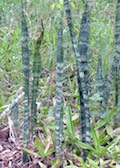 |
Sansevieria trifasciata Mother-in-law’s tongue |
Rhizomatous perennial with erect leaves to c. 1m long | Dig out and remove entire plant including leaves For more info please see: BCC weed identification |
AUD: nil QLD: nil BNE: Reduce Rating: *** |
A weed of dry areas; probably spread by disposal of garden rubbish.
Don’t leave excised leaves on ground as they can sprout plantlets along the margins. |
|
| Images not currently available | Schizachyrium microstachyum Little bluestem |
Grass | Foliar spray
For more info please see: BCC weed identification |
AUD: nil QLD: nil BNE: Special Investigation List Rating: * |
Uncommon | |
 |
Senecio madagascariensis Fireweed |
Yellow-flowered annual or short-lived perennial daisy, each flower head with about 12 petals | Dig out isolated plants before seeding; foliar spray, several selective herbicides recommended
For more info please see:
|
AUD: WONS QLD: C3 BNE: Reduce Rating: * |
A quick-growing plant which seeds prolifically.
Toxic to livestock. |
|
 |
Setaria sphacelata South African pigeon grass |
Perennial grass to 180cm tall; flower heads cylindrical, with c. 1mm bristles | Dig out isolated plants before seeding For more info please see: BCC weed identification |
AUD: nil QLD: nil BNE: Reduce Rating: * |
A pasture species not usually frequent in bushland.
Suggested replacements: Replace with locally native grasses and understorey shrubs. |
|
| Images not currently available | Solanum nigrum Blackberry nightshade |
Shrub to 1.25m; star-shaped flowers
Fruit purple-black when ripe |
Dig out; foliar spray – dicamba or fluroxypyr
For more info please see:
|
AUD: nil QLD: nil BNE: Reduce Rating: ** |
Can be toxic.
Suggested replacements: Replace with locally native understorey shrubs. |
|
 |
 |
Sphagneticola trilobata Singapore daisy |
Rhizomatous perennial, glossy leaves, yellow daisy flowers | Foliar spray, metsulfuron methyl For more info please see:
|
AUD: nil QLD: C3 BNE: Reduce Rating: **** |
A major weed along riparian areas and difficult to control. Mainly reproduces vegetatively. |
 |
Sporobolus pyramidalis Giant rats tail grass |
Narrow leaved tussock grass, pyramidal flower head | Spot spray, glyphosate or flupropanate For more info please see:
|
AUD: nil QLD: C3 BNE: Reduce Rating: *** |
Not palatable to livestock. Several Sporobolus species occur in the Moggill Creek catchment, mostly exotic.
Suggested replacements: in bushland areas replace with locally native grasses. |
|
 |
Tagetes minuta Stinking roger |
Annual with erect stems and deeply divided leaves | Hand pull or foliar spray
For more info please see: BCC weed identification |
AUD: nil QLD: nil BNE: Reduce Rating: * |
A minor annual roadside weed in the Moggill Creek catchment. | |
 |
Tithonia diversifolia Japanese sunflower |
Erect stems to 3m tall; yellow daisy-like flowers to 10cm wide; leaves with 3-7 pointed lobes | Foliar spray – several selective herbicides listed
For more info please see:
|
AUD: nil QLD: nil BNE: Reduce Rating: ** |
Generally occurs in sunny situations.
Suggested replacements: replace with locally native shrubs and small trees. |
|
 |
Tradescantia fluminensis Wandering Jew |
Trailing ground-cover plant with white flowers, 3 petals (easily confused when not in flower with the native Commelina cyanea) | Hand pull and collect for disposal (with care); spot spray fluroxypyr or treat with picloram For more info please see:
|
AUD: nil QLD: nil BNE: Reduce Rating: ** |
Tolerant of heavy shade and difficult to control. | |
 |
Tradescantia zebrina Zebrina |
Trailing ground-cover plant with bi-coloured purple and grey-green leaves | Hand pull and collect for disposal (with care); spot spray with fluroxypyr For more info please see:
|
AUD: nil QLD: nil BNE: Reduce Rating: ** |
Generally spreads vegetatively. | |
 |
Urochloa decumbens Signal grass |
Grass with flower heads to 1.5m; flower heads with several branches tending to be on one side | Dig out isolated plants before seeding; foliar spray For more info please see: BCC weed identification |
AUD: nil QLD: nil BNE: Reduce Rating:***** |
A major weed species in eucalypt woodlands in the Moggill Creek catchment.
Unpalatable to horses. |
|
| 5. AQUATIC AND SEMI-AQUATIC |
||||||
Species |
Detailed view |
Scientific name |
Distinguishing characteristics |
Control |
Status and Rating |
Additional local notes |
 |
 |
Egeria densa Elodea Dense water weed |
Remove completely
For more info please see: BCC weed identification |
AUD: nil QLD: nil BNE: Contain Rating: ** |
||
| Images not currently available |
Eichhornia crassipes Water hyacinth |
Floating water plant with purple flowers | Foliar spray – several herbicides listed
For more info please see:
|
AUD: WONS QLD: C3 BNE: Contain Rating: ** |
On a small scale, hand removal recommended. | |
 |
 |
Gymnocoronis spilanthoides Senegal tea |
Semi-aquatic plant rooting in ground with stems extending over water; leaves opposite; white pompom flowers | Herbicides listed for use in aquatic areas
For more info please see:
|
AUD: NEAL QLD: C3 BNE: Eradicate Rating: *** |
Suggested replacements: Lomandra hystrix |
 |
Heteranthera reniformis Kidney leaf mud plantain |
Aquatic plant that can form dense mats |
For more info please see:
|
AUD: nil QLD: nil BNE: Reduce Rating: * |
||
 |
Hygrophila costata Hygrophila |
Herbaceous, semi-aquatic; leaves in opposite pairs; flowers white, in leaf axils | Remove by hand; foliar spray glyphosate or metsulfuron-methyl For more info please see:
|
AUD: nil QLD: C3 BNE: Eradicate Rating: * |
Suggested replacements: Lomandra hystrix | |
 |
Myriophyllum aquaticum Parrot’s feather |
Aquatic plant with stems creeping and rooting, also forming dense mats on water surface; leaves short, in whorls | Remove by hand For more info please see: BCC weed identification |
AUD: nil QLD: nil BNE: Reduce Rating: ** |
||
| Images not currently available | Nymphaea caerulea ssp. zanzibarensis Water lily |
Blue-flowered water lily | Complete removal For more info please see: BCC weed identification |
AUD: nil QLD: nil BNE: Reduce Rating: * |
||
| Images not currently available | Pistia stratiotes Water lettuce |
Free floating aquatic | Remove by hand; several herbicides listed For more info please see:
|
AUD: nil QLD: C3 BNE: Contain Rating: * |
||
 |
Sagittaria platyphylla Saggitaria |
Herbaceous, semi-aquatic; leaves oval, to 25cm long; flowers with 3 white petals | Spot spray with glyphosate For more info please see:
|
AUD: WONS QLD: C3 BNE: Eradicate Rating: ** |
||
 |
Salvinia molesta Salvinia |
Floating aquatic fern | Several herbicides listed For more info please see:
|
AUD: WONS QLD: C3 BNE: Contain Rating: **** |
||
 |
Colocasia esculenta Taro, Black Stem Taro, Black Stem Elephant’s Ear |
Herbaceous, semi-aquatic plant with large leaves carried on long petioles | Cut stump or foliar spray – avoid spraying close to water
For more info please see: BCC weed identification |
AUD: nil QLD: nil BNE: Reduce Rating: ** |
Common along waterways in the Moggill Creek catchment | |

